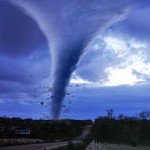The United States experiences more flood damage than any other weather-related event. Stocking food for the family is one of the most important things to do. Dehydrated food or freeze-dried food such as Wise Food Storage products would be ideal because it is light and is easy to prepare. As an added bonus, Wise Food Storage gives you tips for staying safe and getting prepared during flood emergency.
Assemble an Emergency Kit
You should always have an emergency kit and check it regularly to make sure everything in it is still in good working condition. Below is what the Red Cross recommends you include. For more information about what to assemble in an emergency kit check out 96 Hour Emergency Kit and Three Day Emergency Kit.
- Water – at least 3-day supply; one gallon person per day
- Food – at least a 3-day supply of nonperishable, easy-to-prepare food; ideally dehydrated or freeze-dried food
- Flashlight
- Battery powered or hand crank radio (NOAA Weather Radio, if possible)
- Extra batteries
- First aid kit
- Medications (7-day supply) and medical items (hearing aids with extra batteries, glasses, contact lenses, syringes, cane)
- Multipurpose tool
- Sanitation and personal hygiene items
- Copies of personal documents (medication list and pertinent medical information, deed/lease to home, birth certificates, insurance policies)
- Cell phone with chargers
- Family and emergency contact information
- Extra cash
- Emergency blanket
- Map(s) of the area
- Baby supplies (bottles, formula, baby food, diapers)
- Pet supplies (collar, leash, ID, food, carrier, bowl)
- Tools/supplies for securing your home
- Extra set of car keys and house keys
- Extra clothing, hat and sturdy shoes
- Rain gear
- Insect repellent and sunscreen
- Camera for photos of damage
Stay Informed
 NOAA Weather Radio, the NOAA website, or local TV or radio stations will issue flood warnings and reports from the National Weather service. If a flood warning is issued for your area, be prepared to evacuate right away and move to higher ground.
NOAA Weather Radio, the NOAA website, or local TV or radio stations will issue flood warnings and reports from the National Weather service. If a flood warning is issued for your area, be prepared to evacuate right away and move to higher ground.
Protect Emergency Food and Water
- Basements are excellent for emergency food storage because of their low, constant temperatures. Ensure that food is elevated enough to stay dry. Better yet, temporarily move your supply to the highest level of the house.
- Keep a supply of bottled water or keep a Katadyn water filter nearby. Do not use the water from a well until it has been tested and deemed safe.
- Wash fruits and vegetables and prepare baby formula with safe water.
- Don’t eat anything that’s come in contact with floodwater.
- Throw out food that is not in waterproof containers (screw caps, pull tops and crimped caps are not waterproof).
- Food in metal cans and flexible metal or plastic pouches can be cleaned by removing labels and sanitizing containers before opening.
- Thoroughly sanitize food prep pans, countertops, dishes and utensils with hot soap and water or a bleach solution.
Return carefully
- Return home only when officials have declared the area safe.
- Before entering your home, check for loose power lines and damaged gas lines. If you see or hear either one, leave immediately.
- As you enter, be aware that wild animals, especially poisonous snakes can seek shelter in flooded houses.
- Wear protective clothing, including rubber gloves and rubber boots.
- Contact your local or state public health department for specific recommendations for boiling or treating water in your area after a disaster as water may be contaminated.
As illustrated by recent events, even if you’re not in a designated flood plain you may be at risk for high water damage in extreme weather conditions. Take some time to assemble a kit and familiarize yourself with basic safety information. Be alert. Be prepared.





Food stored in the freezer lasts variable amounts of time,
and all different types of sustenance can be frozen.
You can even make dehydrated food at home if you have the right equipment.
If these things happen to you, you will be
glad that you had some emergency food stored in your cupboard or basement.